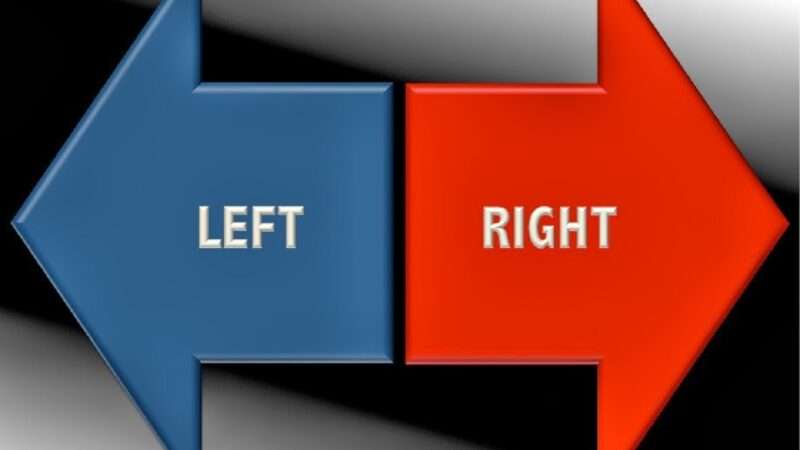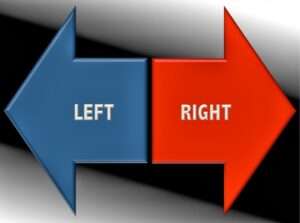

If you follow political issues, you probably often see references to the "left" and the "right." These terms are ubiquitous. But what do they really mean? Do they capture any systematic distinctions that cut across time and space, or are they just arbitrary labels of convenience, perhaps even ones that oversimplify and mislead?
Over the years, there have been various attempts to develop systematic theory of left and right. Recently, prominent liberal political commentator Matt Yglesias wrote an article arguing that the key differences are that the right supports religion and hierarchy, while the left is secularist and egalitarian. He argues this distinction unifies all or most left-right conflicts from the French Revolution to the present.
Libertarian economist Bryan Caplan (my colleague at George Mason University) has for several years been promoting his "simplistic theory of left and right." As he summarizes it:
- The left is anti-market.
- The right is anti-left.
Both Yglesias and Caplan offer interesting insights, and I'm a big fan of both their writings on a variety of other issues. The Yglesias article is a helpful overview and summary of a great many left-right conflicts. And Caplan's position captures some genuine dynamics.
But, ultimately, neither theory really works as an overarching classification system. Many movements don't fit the two theories, or outright contradict them.
Let's take Yglesias' religion/hierarchy theory first. If religion is right-wing, it's hard to explain explicitly leftist religious movements such as Liberation Theology, which combines Catholicism and Marxism. Worse, it's hard to explain the position of the mainstream Catholic Church!
Pope Francis is socially conservative on issues like abortion. But he also takes positions usually considered left-wing on economic regulation, the rights of migrants, the welfare state, and environmental policy. While the present pope has taken some of the Church's "left" positions further than his recent predecessors, the general idea of combining interventionist positions on economic issues with social conservatism is one the Catholic Church has held for a long time.
If your religion-focused theory of left and right has grave difficulty accounting for the leadership of the world's largest religious denomination, that seems like a significant problem for the theory. And Catholicism is far from the only denomination that doesn't fit the theory well. Many Protestant, Jewish, and Muslim movements, for example, are also anomalies in Yglesias' framework.
The hierarchy side of the theory also has issues. Consider the fact that communist regimes feature rigid hierarchies, with power concentrated in a small elite at the apex of the ruling party. Does that make communist regimes "right wing"? Are their opponents, therefore, necessarily left-wing? What if they are conservatives or religious traditionalists, like Alexander Solzhenitsyn? A theory under which Stalin and Mao are right-wing and Solzhenitsyn left-wing seems problematic. At the very least, it's highly counterintuitive.
Yglesias' hierarchy prong creates other anomalies, as well. For example, he notes that a radical Islamist citizen of Israel would be considered left-wing under the theory, presumably because such a person is opposed to the dominant hierarchy in his or her country. If radical Islamists can qualify as left-wing despite their extreme sexism, homophobia, intolerance, and rejection of secularism, that's yet another problem for the theory.
Caplan's approach has issues of its own. There is some truth to the idea that many rightists are more "anti-left" than anything else. For example, it sometimes seems like right-wing Twitter influencers prioritize "owning the libs" over every other objective, including consistency with their own previously professed values. It is also true that many people generally considered left-wingers are deeply anti-market.
But the theory has problems, nonetheless. If the main focus of the right is being anti-left, and left-wingers are defined by their hatred of markets, one would expect right-wingers to be highly pro-market! In such a framework, being pro-market would be the most anti-left stance possible.
Yet, throughout history, there have been many right-wing movements that are highly anti-market themselves. Consider, for example, the Nazis, fascists, and a variety of other nationalist movements, up to and including today's "national conservatives" in the US.
Moreover, there are important right-wing movements that focus primarily on agendas of their own, not just opposing the left. That is true of many of the aforementioned nationalists. It is also true of many religious social conservatives. These people—many of them, at least—genuinely believe that abortion is murder, or that same-sex marriage is likely to erode the foundations of Western civilization. If they are anti-left, it is because the left supports these things they hate, not because being anti-left is itself their primary motive.
Caplan's conception of the left also has shortcomings. Some left-wing movements really are defined by their hostility to the market. That is surely true of most varieties of socialism, for example. Others, however, clearly prioritize different issues, such as promoting racial and gender equality, or enhancing bodily autonomy. Those focused on the latter issues will sometimes even advocate radical reductions in government regulation of the market (as with, e.g., efforts to abolish the War on Drugs, end immigration restrictions, and so on).
Caplan, Yglesias, or both could potentially respond to my criticisms by saying they are arguing for a different way of using "right" and "left" than is common today. If the correct theory of right and left concludes that communists are right-wing and radical Islamists left-wing (at least in Israel), then we should just get used to calling them that! But such linguistic revisionism is unlikely to succeed, and it isn't clear what value it would have if it did.
Ultimately, I lean towards Verlan Lewis and Hyrum Lewis's argument in their recent book The Myth of Left and Right, which holds that "left" and "right" are ultimately arbitrary classifications that denote very different things at different times and places. For example, US right-wingers today tend to be anti-abortion, but that isn't true of most of their European counterparts, and wasn't necessarily true of their own predecessors in earlier eras of American history (e.g.—Ronald Reagan was pro-choice as governor California in the late 1960s).
I still sometimes use "right" and "left," because the terms are hard to avoid. But I don't think they refer to a deep underlying continuity across time and space, dating back to 18th century. At best, they refer to the clustering of positions on the political spectrum at a given time and place. When that clustering changes (e.g.- right-wingers in the US have become much more hostile to free markets in recent years), the use of the terms also changes—or starts to become confusing.
By contrast, there are deep continuities when it comes to more specific ideologies, such as socialism, libertarianism, liberalism, and nationalism. Today's socialists have much in common with their 19th century predecessors, such as advocacy of state control of the economy and economic egalitarianism. Today's libertarians have much in common with forbears like John Locke and Adam Smith (e.g.- support for strong property rights and tight limits on government power across a wide range of issues). Libertarianism is just one branch of liberalism. And today's liberal movements still have much in common with their Enlightenment roots (e.g.—reliance on reason, skepticism of tradition, support for a variety of strong individual rights). Finally, today's nationalists have much in common with those of a century ago, including the Nazis and fascists.
Advocates of libertarianism, socialism, liberalism, and nationalism in different countries, also have important commonalities. For example, socialists in many different societies favor similar economic policies. Bernie Sanders' positions on most economic issues are similar to those of his European counterparts. The same goes for libertarians. For example, most of the economic policy agenda of Javier Milei, the libertarian-leaning president of Argentina, is instantly recognizable to US libertarians (myself included).
Obviously, there are noteworthy internal disagreements among libertarians, socialists, and adherents of other specific ideologies. But they tend to be much narrower than those often encountered within the nebulous categories of "right" and "left."
The post What Differentiates the Political Left and Right? appeared first on Reason.com.







